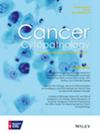Comparison of conventional and novel rotational FNA needles using conventional microscopy and image analysis to quantitatively assess yield
Abstract
Background
There is increasing interest in designing new fine-needle aspiration (FNA) needles to maximize tissue acquisition. This study compares cytological preparations from a new rotating FNA needle (CytoCore) with conventional FNA (ConvFNA) using semiquantitative evaluation and quantitative image analysis (IA).
Methods
FNA were performed on ex vivo tissue in quadruplicate for each needle type (ConvFNA and CytoCore), including different sizes (22 G and 25 G) and variable procedure time (5 and 20 s). The Nikon Elements (v5.41.02) was used to quantify the cellularity and size of the largest tissue fragment on cell blocks.
Results
A total of 96 cytology specimens were evaluated were evaluated from benign and malignant specimens. For both ConvFNA and CytoCore, a longer procedure time (20 s) tended to produce greater cellularity and larger tissue fragments in the cell block specimens for both needles when analyzed with image analysis and was statistically significant for the CytoCore needle (p < .01). The ConvFNA tended to perform better with short procedure time. There was no statistically significant difference using different needle gauges.
Conclusion
This study shows that IA can help to quantitatively evaluate sample cellularity in the cell blocks from specimens acquired with different needles. A longer procedure time tended to produce more cellular samples and larger tissue fragments in the cell block for both ConvFNA and CytoCore needles and was statistically significant for CytoCore. Additional larger studies, including those with true clinical cases, should be considered to evaluate the different needle types further.




 求助内容:
求助内容: 应助结果提醒方式:
应助结果提醒方式:


